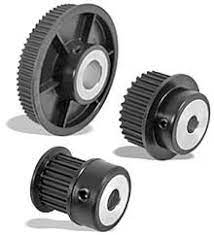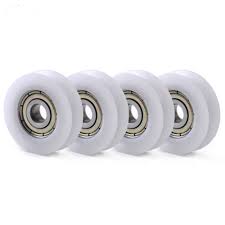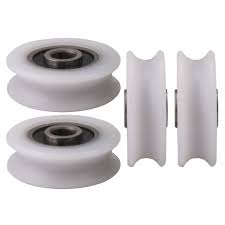Product Description
Customized Cable Pulley Block Plastic Xihu (West Lake) Dis. Pulley
Product Parameters
Main Specifications
| Item number | Model | Number of sheave | Rated load (kN) | Weight (kg) | Feature |
| 10168-1 | SHDN1160 | 1 | 60 | 65 | Middle :MC nylon sheave |
| 10168-2 | SHSQNK1160 | 3 | 120 | 220 | Middle :MC nylon sheave Conductor: rubber lined MC nylon sheave |
Notes:
1. Maximum suitable conductor ACSR1250
2. Sheave Dimension for conductor (outside diameter× root diameter × sheave width) Φ1160×Φ1000×150(mm).
3. Sheave Dimension for steel wire rope (outside diameter× root diameter × sheave width) Φ1160×Φ1000×130(mm).
4. The rubber lined MC nylon sheave is half lined.
To support the Transmission work, CHINAMFG Power has Tubular Gin Pole, Hydraulic cable puller, wire rope pulley block, hoisting tackle, Wire rope gripper , Cable reel spool and stand- all are OEM and professionally produced per ISO 9001:2008, which are being sold to over more than 50 countries in the world. Some items like emergency restoration tower and crossing structure, we can customized, and the safety tools and accessories, are not demanded the MOQ. You can freely help you out either Tech issue or Products requirements. Pls contact us. Thanks.
1. Training and services.
CHINAMFG is a company specializing in the development, design and manufacture of electrical construction equipment and tools. We not only manufacture and sell international standard products, OEM and custom products, but also provide quality tracking and service monitoring.
2. How about the quality of your products?
Our products are manufactured in strict accordance with national and international standards, and each product is tested before delivery. If you would like to view our quality certification and various test reports, please consult us.
3. Why do you choose us?
Because we can provide you with excellent service, quality and reasonable price. In addition, we can also provide smooth delivery of goods, excellent customer solutions.
4. Customer inquiry.
If there is an emergency, customers can also use online contact methods (online Chat, Skype, WhatsApp, ) for faster and better communication. Any enquiry will be answered within 12 working hours.
5. How to obtain samples?
We can provide free samples to the buyer for testing, but the buyer needs to pay the freight. Existing samples take 2-3 days. If there is no stock, we will advise the delivery date.
6. How about packing and shipping?
All goods will be packed in plywood boxes for safe, long haul transport. Support EXW, FOB, CIF, CFR terms.
Required documents such as packing list, commercial invoice, bill of lading, air waybill, CO, Form E, Form F etc will be provided.
Note: If you do not find the product you need, please feel free to contact us. We will provide the best quotation as soon as we verify your requirements.
/* January 22, 2571 19:08:37 */!function(){function s(e,r){var a,o={};try{e&&e.split(“,”).forEach(function(e,t){e&&(a=e.match(/(.*?):(.*)$/))&&1
| After-sales Service: | 1 Year |
|---|---|
| Warranty: | 1 Year |
| Type: | Pull-Line Fitting |
| Samples: |
US$ 150/Piece
1 Piece(Min.Order) | Order Sample |
|---|
.shipping-cost-tm .tm-status-off{background: none;padding:0;color: #1470cc}
|
Shipping Cost:
Estimated freight per unit. |
about shipping cost and estimated delivery time. |
|---|
| Payment Method: |
|
|---|---|
|
Initial Payment Full Payment |
| Currency: | US$ |
|---|
| Return&refunds: | You can apply for a refund up to 30 days after receipt of the products. |
|---|
How are plastic pulleys used in material handling and packaging machinery?
Plastic pulleys play a crucial role in material handling and packaging machinery. Here’s a detailed explanation:
1. Conveyor Systems:
In material handling applications, plastic pulleys are commonly used in conveyor systems. Conveyor belts are driven by pulleys, and plastic pulleys are favored for their lightweight yet durable construction. Plastic pulleys provide smooth and reliable power transmission, ensuring efficient movement of materials along the conveyor belt. They are resistant to corrosion, which is particularly advantageous in environments where moisture or chemicals may be present.
2. Tensioning and Tracking:
Plastic pulleys are utilized for tensioning and tracking purposes in material handling machinery. Tensioning pulleys help maintain the appropriate tension of belts or chains in conveyor systems, preventing slippage and ensuring consistent movement. Plastic pulleys are often equipped with built-in bearings or bushings, facilitating easy rotation and adjustment. Additionally, plastic pulleys with tracking grooves or flanges are used to keep belts aligned and centered, minimizing the risk of misalignment or product damage.
3. Packaging Machinery:
In packaging machinery, plastic pulleys are employed in various applications. They are frequently used in equipment such as wrapping machines, carton sealers, labeling machines, and case packers. Plastic pulleys assist in the smooth movement and positioning of packaging materials, ensuring precise and efficient packaging operations. Their lightweight nature minimizes the load on the machinery, allowing for faster acceleration and deceleration during packaging processes.
4. Bottle and Container Handling:
Plastic pulleys find extensive use in bottle and container handling systems. These systems are responsible for transferring bottles or containers from one location to another, such as filling stations, capping machines, or labeling stations. Plastic pulleys with specific designs, such as grooves or teeth, enable secure grip and smooth transfer of bottles or containers, preventing slippage or damage. They are also resistant to chemical substances commonly found in the packaging industry.
5. Rotary Tables and Indexers:
Rotary tables and indexers are commonly used in material handling and packaging machinery to control the precise movement and positioning of products. Plastic pulleys are utilized in these systems to provide smooth and accurate rotation or indexing. They contribute to the precise alignment of workpieces or products, ensuring reliable and consistent performance. Plastic pulleys with low friction properties enhance the efficiency of rotary tables and indexers, reducing power consumption and wear.
6. Automated Guided Vehicles (AGVs):
AGVs are autonomous mobile robots used for material handling applications within warehouses or manufacturing facilities. Plastic pulleys are often incorporated into the drive systems of AGVs to facilitate smooth movement and steering. These pulleys contribute to the accuracy and reliability of AGV navigation, enabling efficient transportation of materials or products. Additionally, plastic pulleys are lightweight, which helps optimize the payload capacity and energy efficiency of AGVs.
7. Ergonomic Handling Equipment:
Plastic pulleys are utilized in ergonomic handling equipment, such as lift-assist devices or ergonomic conveyors. These systems are designed to reduce the physical strain on operators during material handling tasks. Plastic pulleys enable smooth and effortless movement of loads, enhancing operator comfort and productivity. Their lightweight construction makes them suitable for portable or adjustable equipment, allowing for versatile and user-friendly handling solutions.
In summary, plastic pulleys are integral components in material handling and packaging machinery. Their versatility, lightweight construction, durability, and resistance to corrosion and chemicals make them well-suited for various applications in these industries. Plastic pulleys contribute to the efficiency, reliability, and smooth operation of machinery, ultimately enhancing productivity and ensuring accurate handling and packaging of materials and products.
What role do plastic pulleys play in automotive engines and accessory systems?
Plastic pulleys play an essential role in automotive engines and accessory systems. Here’s a detailed explanation of the role of plastic pulleys in these applications:
1. Belt Driven Systems:
In automotive engines, plastic pulleys are commonly used in belt-driven systems. These systems include components such as the alternator, power steering pump, air conditioning compressor, water pump, and various accessory drives. Plastic pulleys are used as the guiding and tensioning components for the belts that drive these systems. They help maintain proper belt tension, ensure smooth operation, and facilitate the transfer of power from the engine to the various accessory components.
2. Lightweight Design:
Plastic pulleys offer the advantage of being lightweight compared to their metal counterparts. This lightweight design contributes to overall weight reduction in the vehicle, which is crucial for improving fuel efficiency and reducing emissions. By using plastic pulleys in automotive engines and accessory systems, manufacturers can achieve weight savings without compromising the strength and durability required for reliable operation.
3. Low Friction and Efficiency:
Plastic pulleys are designed to have low friction surfaces. This characteristic reduces the resistance encountered by the belts during operation, resulting in improved efficiency. The reduced friction helps optimize the power transfer from the engine to the accessory systems, ensuring that energy is not wasted and maximizing the overall efficiency of the vehicle. The use of plastic pulleys helps minimize energy losses and contributes to the performance and fuel economy of the automotive engine.
4. Corrosion Resistance:
Automotive engines and accessory systems are exposed to various environmental conditions, including moisture, heat, and chemicals. Plastic pulleys offer excellent resistance to corrosion, which is particularly beneficial in these demanding environments. Unlike metal pulleys that may rust or corrode, plastic pulleys remain unaffected by moisture or chemicals. This corrosion resistance ensures long-lasting performance and reduces the need for frequent replacements, contributing to the reliability and longevity of automotive engines and accessory systems.
5. Noise and Vibration Damping:
Plastic pulleys have inherent damping properties that help reduce noise and vibration in automotive engines and accessory systems. The damping effect of plastic materials absorbs vibrations generated during belt operation, resulting in smoother and quieter system performance. This is important for improving the overall driving experience and reducing the noise levels inside the vehicle cabin. Plastic pulleys help minimize noise and vibration, contributing to user comfort and the overall quality of the vehicle.
6. Design Flexibility:
Plastic pulleys offer a high degree of design flexibility, allowing for precise customization to match the specific requirements of automotive engines and accessory systems. They can be molded into various shapes, sizes, and configurations, enabling efficient integration into different engine layouts and space constraints. Plastic pulleys can incorporate features such as grooves, flanges, or mounting options directly into the design, ensuring optimal belt engagement and alignment. This design flexibility helps optimize the performance and reliability of automotive engines and accessory systems.
7. Cost-Effectiveness:
Plastic pulleys are generally cost-effective compared to their metal counterparts. The manufacturing process for plastic pulleys is typically less complex and less expensive, resulting in lower production costs. This cost advantage makes plastic pulleys a preferred choice in automotive applications where multiple pulleys are required, such as in serpentine belt systems. Plastic pulleys offer a balance between performance, durability, and affordability, contributing to the cost-effectiveness of automotive engines and accessory systems.
In summary, plastic pulleys play a vital role in automotive engines and accessory systems by guiding and tensioning belts, providing lightweight design, reducing friction and improving efficiency, offering corrosion resistance, damping noise and vibration, providing design flexibility, and delivering cost-effectiveness. Their contributions to these systems result in better performance, fuel efficiency, reliability, and overall driving experience in vehicles.
Can you explain the key features and advantages of plastic pulleys?
Plastic pulleys offer several key features and advantages that make them suitable for various applications. Here’s a detailed explanation of the key features and advantages of plastic pulleys:
1. Lightweight:
One of the significant features of plastic pulleys is their lightweight construction. Compared to metal pulleys, plastic pulleys are considerably lighter, which can be advantageous in applications where weight reduction is desired. The lightweight nature of plastic pulleys makes them suitable for applications where minimizing overall system weight is important, such as in portable devices or equipment.
2. Corrosion Resistance:
Plastic pulleys are inherently resistant to corrosion. Unlike metal pulleys that may rust or corrode when exposed to moisture or certain chemicals, plastic pulleys maintain their integrity and functionality even in corrosive environments. This corrosion resistance makes plastic pulleys suitable for applications where exposure to moisture or chemicals is likely, such as in marine equipment or outdoor machinery.
3. Low Friction:
Plastic pulleys generally have low friction coefficients. This means that the contact between the pulley and the associated components, such as belts or ropes, is smoother, resulting in reduced frictional losses. The low friction properties of plastic pulleys contribute to improved efficiency and energy savings in various systems, such as conveyor belts, where reducing power consumption is desirable.
4. Noise Reduction:
Plastic pulleys offer inherent damping properties, which help reduce noise and vibration during operation. The damping effect of plastic materials absorbs vibrations and minimizes noise generation, resulting in quieter operation compared to metal pulleys. This makes plastic pulleys suitable for applications where noise reduction is important, such as in household appliances or office equipment.
5. Design Flexibility:
Plastic pulleys offer a high degree of design flexibility. They can be molded into various shapes, sizes, and configurations, allowing for precise customization. This flexibility in design enables specific features, such as flanges, grooves, or mounting options, to be incorporated directly into the pulley. Plastic pulleys can be tailored to meet the unique requirements of different applications, making them highly versatile in terms of design possibilities.
6. Cost-Effective:
Plastic pulleys are generally more cost-effective compared to pulleys made from other materials, such as metal, ceramic, or glass. The manufacturing process for plastic pulleys is typically less complex and less expensive, resulting in lower production costs. This cost advantage makes plastic pulleys a cost-effective choice for a wide range of applications, especially in situations where budget constraints are a consideration.
7. Electrical Insulation:
Plastic pulleys offer electrical insulation properties. Unlike metal pulleys that conduct electricity, plastic pulleys act as insulators, preventing the flow of electrical current. This electrical insulation characteristic is advantageous in applications where electrical conductivity needs to be avoided or isolated, such as in electronic devices or systems with sensitive electrical components.
8. Chemical Resistance:
Plastic pulleys exhibit resistance to various chemicals, depending on the specific plastic material used. They can withstand exposure to substances such as oils, fuels, solvents, and acids without degradation. This chemical resistance makes plastic pulleys suitable for applications where contact with chemicals or aggressive substances is expected, such as in industrial machinery or chemical processing equipment.
In summary, plastic pulleys offer key features and advantages including lightweight construction, corrosion resistance, low friction, noise reduction, design flexibility, cost-effectiveness, electrical insulation, and chemical resistance. These attributes make plastic pulleys suitable for a wide range of applications across industries such as automotive, consumer electronics, manufacturing, and more.
editor by CX
2024-05-14




